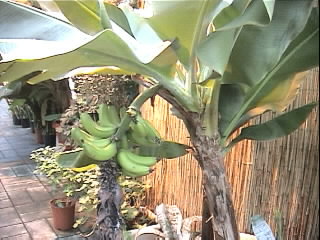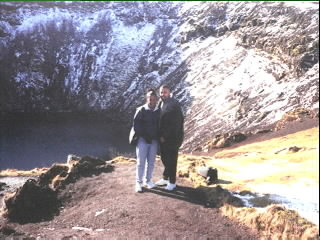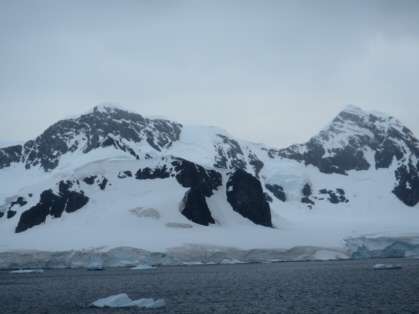The activities and recreation organization at work was offering a trip to Iceland. Iceland is one of those countries I rarely hear anything about. It had never been on the list of places I wanted to visit, but the opportunity was presented and I was curious. This was a short, enjoyable trip to a land full of geological wonders and friendly people. We saw geysers, waterfalls, volcanoes, lava fields, and historic buildings. Additionally, we did some sightseeing in Reykjavik (capital city of Iceland), had incredible meals, and relaxed in the Blue Lagoon, which is one of Iceland's many natural hot springs. All these activities made for a fun but short vacation. However, the thing I think I will remember most about Iceland is the weird, changeable weather. You've got to experience it to believe it.
Things I Really Enjoyed
- The Blue Lagoon: The Blue Lagoon consists of natural hot water pumped from a mile below the surface onto a lava field. Even though the air temperature was in the mid-30's and windy, we relaxed in this warm (sometimes hot) water. It felt great!
- The Food: I never had a bad meal during my stay in Iceland. Fish and lamb are the most popular foods there. The seafood was always fresh and the lamb was always tender and well-seasoned.
- Gulfoss (Golden Falls): We saw this powerful, two-tiered waterfall during our Golden Circle Tour. To see and hear this awesome display of nature's force was a humbling experience.
- Geysers: Another stop on the Golden Circle Tour was a geothermal field containing geysers, hot springs, and boiling mud. The spouting geyser, Strokkur, and all the steam rising from the ground gave the area a mystical appearance and also made for some good pictures. It was fun trying to capture the spouting geyser on film.
- Flight Over Greenland: During our flight back to the U.S., we flew over Greenland. We could see snow covered mountains, huge icebergs, fjords, glaciers, and a gigantic blanket of snow that was as high as some of the mountains. I have never seen so much snow in my life. It was a beautiful sight.
Things That Disappointed Me
- Hot Bar of the Breakfast Buffet: The food on the hot bar of the complimentary breakfast buffet was cold! There is nothing like cold, runny scrambled eggs in the morning. Yuck!
- Wasted Arrival Day: We arrived in Iceland 6:45 a.m. (1:45 a.m. EST). Traci and I let jet lag get the best of us and slept most of the afternoon. Had I known that the organized tours we took during the rest of our stay returned us to the hotel after most of the museums and shops in Reykjavik had closed, Traci and I would have done some exploring on our own on our arrival day instead of sleeping. We ended up cramming all of our exploring into the morning we were leaving to return to the U.S..
A Few Facts
Where is Iceland?
Iceland is an island nation about the size of Kentucky. It sits in the North Atlantic barely touching the Arctic Circle between Greenland and Europe.
The Language
The people of Iceland speak Icelandic. It was the language of the Vikings that settled on the island over 1000 years ago. Because Iceland remained isolated from the rest of the world for so many centuries, the language has changed very little since the first settlers landed there. There are 32 letters in the Icelandic alphabet (only 26 in the English alphabet) and their words are sometimes very long. I remember being amazed at how many words I saw that contained more than 20 letters.
I was surprised to find out that most Icelanders speak fluent English. They are required to learn it in school. Many of the signs are in Icelandic and English. We had no problems communicating during our stay.
The Currency
The currency of Iceland is the Icelandic króna. At the time we were there, one U.S. dollar was approximately equal to 80 ISK. The exchange rates varied depending on where we exchanged money. I exchanged petty cash for riding the public buses at the hotel at 73 ISK/$1. For other purchases I used my credit card.
The Trip Report
Let me try to guess what you are thinking. "Why did you want to go to Iceland? Isn't it cold there? Where is Iceland? Does anyone live in Iceland? Isn't that a long way to travel for a weekend getaway? What's in Iceland?"
Perhaps it was the latter question that really influenced me to go on this trip. The whole thing came about when I saw a flyer from the activities and recreation organization at work advertising an "Iceland Getaway". At first glance, I thought it was a trip to an ice skating rink. At closer inspection, I realized the flyer was actually advertising a four-day trip to the country of Iceland. I became curious as to what is in Iceland and why anyone would want to go there. Curiosity got the best of me so I read a little more. The trip was $750 per person and included round trip airfare, hotel, breakfast, and tours. I took the flyer home to Traci to see if she was as curious as I was. I showed her the flyer and asked her if she wanted to go. Her reply was, "I don't care.". With that, we signed up for the trip and sent our deposit.
There were 45 of us who went on the trip. We all met in the parking lot at work and rode a motor coach to BWI airport in Baltimore. We flew Icelandair from BWI to Keflavík airport in Iceland (UPDATE: As of January 2008, Icelandair no longer flies out of BWI). It was a 5 hour flight that put us in Iceland at 6:45 a.m. GMT (1:45 a.m. EST). Needless to say, most of us were pretty jet-lagged upon arrival.
A Strange Land
We were met at the airport by our tour guide, Kristine, from the Reykjavik Excursion tour company. She was a tall, elderly Icelandic woman with a warm smile. We boarded the motor coach that was waiting for our group and headed to our hotel in Reykjavik, the capital city of Iceland. During the 45 minute ride to Reykjavik, Kristine pointed out sights and gave us facts about the country. I was totally amazed by what I saw during the bus ride. It had to be the strangest and most eerie landscape I've ever seen. There were no trees, no bushes, no grass, no flowers - just miles and miles of black lava rocks sparsely covered with moss. This is known as a lava field and there is no shortage of them in Iceland. In the distance you could see mountains and volcanoes. The lava fields and mountains against the backdrop of the dark gray, dreary sky, made me feel like I had stepped onto the set of a science fiction disaster movie.
It is believed that there were many trees in Iceland when the first settlers came there; however, the place was de-forested because of the need for wood to make heat and to build houses. Scientists are now trying re-forest the country by planting trees from Alaska and Norway.
Weird Weather
Before going on this trip, I had done a fair amount of reading on Iceland. Most of the literature I read said that Iceland has relatively mild weather for being so close to the Arctic Circle because it is in the Gulf Stream. I remember reading that New York actually has colder winters than Iceland. All this may be true according to a thermometer but I don't remember anyone saying anything about the vicious wind and the very volatile weather. I have never experienced weirder weather than I did in Iceland. This place gives a whole new meaning to the term 'volatile weather'. You can experience all the seasons in one hour. We would be standing in bright sunny weather, typically mid 30's to lower 40's, and then out of nowhere, we would find ourselves running for cover from a hailstorm. By the time we would take cover, it was sunny again. Just when we'd think it was safe to come out again, buckets of rain would begin to fall. We never knew what type of precipitation was going to fall from the sky from one minute to the next. Sometimes it was snow or sometimes sleet. There was also precipitation our tour guide referred to as sledge. I'm still not exactly sure what that is. Just when we would think all the precipitation was finished, the strong arctic winds would start. They were sometimes strong enough to blow you off balance if you weren't careful. There was a bright side to all this spontaneous weather, and that is the rainbows. Rainbows are common sight in Iceland.

"Hailstorm? Wasn't it sunny a minute ago?"
I also read that early settlers named the country Iceland because they wanted to keep this new lush green land they found to themselves. They gave Greenland, which is an extremely cold and snow-covered place, its name because they wanted to encourage people to go there. I found out from our tour guide that this story is only half true. The part about Greenland is valid; however, Iceland actually got its name from an explorer who saw icebergs floating in a fjord.
Welcome To Reykjavik
En route to our hotel, Hotel Loftleidir (Hótel Loftleiđir), Kristine informed us that our rooms were not ready yet. Instead, we would eat breakfast and then get back on the bus to take the two hour city tour of Reykjavik.
The Hotel Loftleidir served a Scandinavian breakfast buffet each morning. This consisted of a hot and cold bar. The cold bar had cold cuts, vegetables, fruit, cereal, bread, and skyr, an Icelandic yogurt. There was also fish. I'm not sure if it was steamed or raw, but it was on the cold bar so I was not trying to taste it.
The hot bar was a disappointment. It had boiled eggs, scrambled eggs, fried potatoes, baked beans, and what looked and tasted like miniature hot dogs. With the exception of the hot dogs, the rest of the food at this station was a disappointment because it was always cold. Therefore, I ended up skipping the hot bar each morning and eating the skyr and cereal instead. Traci enjoyed toast, oranges, and skyr for breakfast.
After breakfast, we piled back onto the bus and took a tour of Reykjavik. Reykjavik, is a colorful city with brightly colored roofs. There are no skyscrapers but it has an active harbor due to an economy heavily dependent on fishing (and whaling at one time). The further we moved away from the harbor, the more the city looked like a U.S. city. There were many recognizable businesses such as McDonald's, Pizza Hut, Toyota, Honda, IBM, Price Waterhouse Coopers, etc... There were many Icelandic businesses that I cannot even begin to spell or pronounce.

Reykjavik, the capital city of Iceland
Our city tour took us by the parliament building, several museums, the university, and several other landmarks. We made several stops along the way. This was good because jet lag really had a grip on us. However, whenever we stepped off the bus into the arctic wind blasts, we woke up right away. We did not have the opportunity to visit the National Museum that contains artifacts from the Viking days because it was closed for renovation.
One of the highlights of this tour was the Hallgrimskrikja (Hallgrímskrikja) Church. This huge Lutheran church (around 90% of Icelanders are Lutheran) is the largest building in Reykjavik and can be seen from just about anywhere in the city. Apparently, there was some controversy when its construction was completed in 1974 because people complained it looked like a lava flow. To me, it looks like a chapel with a gigantic rocket attached to it. Outside of the church is a statue of Leif Ericsson, which was given to Iceland by the U.S.. Leif Ericsson was born in Iceland and is credited for being the first European to set foot in North America in 1000 A.D.. We were allowed to enter the church and look at its 5000-piped organ. Unfortunately, we did not get a chance to hear it. Ordinarily, this tour allows visitors to go to the top of the bell tower and get a lovely panoramic view of the city. For some reason, Kristine informed us that we were not going to be doing that on this tour. Instead, she said we would be making a stop at Perlan (The Pearl) to get our panoramic view of Reykjavik.

Hallgrimskrikja Church (before another downpour)

Pipes of the Hallgrimskrikja church organ
Perlan is an upscale restaurant and museum that sits high on a hill and atop six water towers. It has an observation balcony on the fourth floor. We went to the balcony and got some nice views of Reykjavik, but we didn't stay out there very long. That arctic wind was vicious!!
Hotel Loftleidir
After our tour of Reykjavik, we were dropped off at our hotel. The rooms were ready so we checked in. The Hotel Loftleidir is owned by Icelandair. It has a very 70'ish exterior; however, it looks rather modern on the inside. Our room was a little on the small side but it was always clean and cozy.
It was a relief to finally check into our hotel room. Because we had an overnight flight, this was the first opportunity we had to shower and change since the day before. Speaking of showers, one thing we had to get used to in Iceland was the sulfur smell (smells like rotten eggs) in the water from the faucets. Iceland is geologically a very young island and has a lot of geothermic and volcanic activity not far beneath its surface. This allows the island to enjoy an abundance of natural hot water. It is used for things like electricity generation, heat, and plain hot water. A side effect of this natural hot water is the sulfur odor. Fortunately, we did not smell it when mixed with soap. After a day or two, I barely noticed the smell when I turned on the shower.
A Wasted Afternoon
After we were clean and fresh, Traci said she wanted to take a nap for an hour. While she did this, I began looking through brochures and guide books to determine some places of interest we should check out while in Iceland. Before I knew it, I had drifted off to sleep too. We woke up after 5 p.m.. This was too late to go to any museums or shops.
At this point, we were pretty hungry, so we decided to figure out how to take the public buses to a Pizza Hut we had passed during our tour of Reykjavik. I know this sounds pretty lame to travel to another country and go to Pizza Hut instead of trying the local cuisine, but we figured we still had two more evenings to try different foods. We had a nice meal at Pizza Hut; however, it was much more expensive than here in the U.S.. Welcome to Iceland!
Golden Circle Tour
Saturday was the day we took the famous Golden Circle Tour. This is an 8 hour tour through the countryside of southwestern Iceland. During this trip we were able to see some of the island's interesting landmarks and natural wonders.
Garden of Eden
This was our first stop leaving Reykjavik. It is a greenhouse heated by water from one of the country's natural hot springs. This natural heat allows many types of plants to be grown here so close to the Arctic Circle - including bananas.
Besides the plants, the thing that you cannot help but notice here is the large souvenir shop and snack bar. Kristine, our tour guide, also referred to this stop as our first "technical stop" (a place with restrooms). Since, the next technical stop would not occur for another 2 hours and there was no lavatory on the bus, she strongly recommended we take advantage of the facilities here.

bananas growing at the Arctic Circle
Kerid (Keriđ) Crater
Kerid is an extinct volcano crater. Not all volcanoes are mountains. This made it easy for us to walk up to it and peer down into the hole which is now filled with water. There are no guard rails at Kerid so we had to be careful when taking pictures.

Traci and me at Kerid Crater
Skalholt (Skálholt)
Skalholt is a Lutheran church seemingly out in the middle of nowhere. It commemorates the site of the church that existed here from the 11th century through the 18th century. The tomb of Bishop Páll Jónnson who served from 1196 to 1211, was discovered during the re-construction of the church in 1954. The bishop's tomb now lies in the basement of Skalholt. We went downstairs and took a look at it along with other artifacts from the bishop's time. We were not able to see the upstairs sanctuary because a ceremony was in progress at the time. I had started to take some video footage of the outside of the church, but a sudden hailstorm sent me and others running back to the bus. continue...





